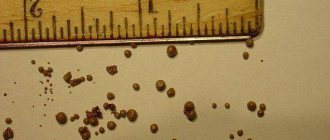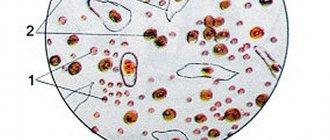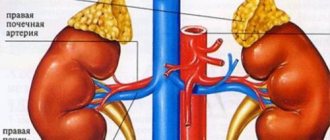A urine test is the very first test ordered by a doctor before making a diagnosis. Thanks to this diagnosis, it is possible to identify the inflammatory process occurring in the body, which is why specialists prescribe it everywhere.
Urine can show not only the amount of protein, leukocytes, red blood cells and other substances leaving the human body, but also indicate the presence of pus in it. If there is a complete lack of transparency in the urine, flakes and sediment are present, they “talk” about pyuria. However, its presence in urine can only be fully confirmed in a laboratory during analysis. If the material reveals an excessive number of leukocytes, then there is pus in the urine.
Why is there pus in the urine? Today, we will look at this issue.
Why is there pus in urine?
The cause of pyuria is often a bacterial infection of the genitourinary system: the human body reacts to tissue irritation by causing an inflammatory reaction, which is manifested by a rush of blood to the area of irritation and swelling of the tissue. This is caused by the fact that the blood delivers an increased number of leukocytes to this area of the body to combat irritants. Therefore, inflammation of the urinary system leads to an increase in white blood cells in urine. In this case, neutrophils are the first to react to the pathogen. If they die in the fight, they form pus, calling new leukocytes to the site of the lesion.
Some people confuse the concepts of pyuria and bacteriuria, although there are differences. Pyuria is the appearance of white blood cells (more than 10) in a urine sample under a microscope . This number of leukocytes is quite enough for the urine to become cloudy or whitish. But the presence of bacteria in the urine (bacteriuria) may either not be observed or be within low limits: with bacteriuria, the number of bacteria must exceed 105 units per milliliter.
In pyuria, the cause of the presence of neutrophils, from which pus is formed, is an inflammatory process, primarily in the genitourinary system. White blood cells act as fighting units of the immune system that attack infectious agents and substances that can harm the body. When this natural reaction of the body occurs, the mucous membrane is also included in this process. The cause of inflammation of the mucous membrane is the presence of too many leukocytes, which are excreted in the urine.
The presence of bacteria in the urine may not indicate the presence of a disease at all. A small amount of them in a sample from healthy people is allowed. This is a normal phenomenon, since the internal environment of the urinary system is saturated with moisture, which is ideal for bacteria to develop and reproduce. But if the number of bacteria is outside the normal range, they can cause infection of the genitourinary system. Bacteriuria can occur with or without symptoms. At the same time, symptomatic bacteriuria can be treated with antibiotics, while asymptomatic bacteriuria often goes away on its own without treatment.
Children
Causes
The causes of the inflammatory process in children are the same as in adults: pathologies of the kidneys, urinary tract, ureters, and genital organs. It is much easier for a child in adolescence to voice his problems than for a newly born baby.
Symptoms
When pus comes out, pain is felt when urinating, discomfort in the lower abdomen and lumbar region, and a frequent urge to urinate. In addition, with pyuria, the urine acquires a ketone odor.
If the inflammatory process is intense, the smell can come not only from urine, but also from the whole body. For a visual examination at home, the child must urinate into a sterile container; if the urine is cloudy, then you should immediately go to a specialist for a full examination.
Causes of pyuria
Bacterial infection is not the only cause of pyuria. Cases where bacteria are not the cause of pus in the urine are much more difficult for the attending physician and require additional examination to make a diagnosis.
The following reasons can cause the appearance of pus in urine:
- Genitourinary tract infection (UTI).
- Bladder infections (cystitis).
- Diseases of the genitourinary system (chlamydia, gonorrhea).
- Prostate infections.
- Viral infections, including herpes and papilloma (condyloma and warts).
- Tuberculosis, anaerobic bacteria (these include microorganisms that live in the complete or partial absence of oxygen), actinomycosis, fungi.
- Parasitic diseases caused by Trichonoma vaginalis, Schistosoma haematobium, Giardia lamblia, Entamoeba histolica.
- Inflammatory kidney diseases - analgesic nephropathy, glomerulonephritis, lead nephropathy.
- Secondary syphilis.
- Systemic diseases (lupus, polyarthritis).
- Taking glucocorticoids.
- Injuries.
Benign and cancerous tumors of the genitourinary system, stones in the kidneys, ureters or bladder can provoke the appearance of pus in the urine. Reiter's syndrome and retroperitoneal fibrosis can provoke inflammation of the genitourinary system. Pyuria can occur due to irritation from detergents and soaps, as well as the presence of drugs in the urethra and bladder.
Pyuria in children
Pathological processes that arise as a response to an external stimulus in boys and girls are as common as in adults.
If a teenager may complain of pain when urinating, frequent urges, then a baby can signal problems only by crying. The reason for contacting a doctor may be the appearance of a ketone odor emanating from urine or the whole body. Restlessness, crying of the baby when performing natural needs, cloudy urine, appearance of blood or pus. Almost every adult has an idea of what pus looks like when it is present in the urine. A doctor will be able to determine whether cloudy urine is a symptom of a disease or caused by natural causes after conducting tests. You should definitely consult a doctor if your baby’s temperature rises for unknown reasons; the temperature rises again within one week. The causes of pyuria in children are the same as in adults. The causes may be pathological processes of the kidneys, bladder, and reproductive system.
Pyuria and pregnancy
A pregnant woman always has an increased risk of developing a genitourinary tract infection, when bacteria that enter there progress to pyuria. The reason for this is intense hormonal changes during pregnancy, which create favorable conditions for infection to enter the genitourinary system.
You should be especially wary if mucus appears in the urine during pregnancy, since it indicates inflammation of the urinary system, in which the outflow of urine is disrupted, causing epithelial cells to increase mucus synthesis, which makes itself felt as white threads. The reason for this may be cystitis, inflammation of the kidneys, the appearance of stones in them and other factors.
Sometimes the cause may be a lack of hygiene, which leads to increased mucus production. Therefore, so that a urine test does not show mucus, it is very important to thoroughly clean the genitals (without soap) before the analysis, and collect the urine in a sterile jar.
UTI, pyuria and bacteriuria in pregnant women should be treated without fail, regardless of the presence of symptoms. This is necessary, since not only the health of the pregnant woman, but also the baby is at risk. The danger is so great that even with asymptomatic pyuria, pregnant women take antibiotics.
Kidney diseases
Pus in the urine may appear as a result of kidney disease. At the moment, there are a number of serious ailments in which such a symptom necessarily appears. Pus cells in the urine can appear even in cases of illness not caused by infection. These kidney ailments include:
- interstitial nephritis;
- glomerulonephritis;
- renal tubular acidosis;
- lupus nephritis;
- polycystic kidney disease;
- renal capillary necrosis.
With the development of such diseases, a urine test may contain not only pus cells, but also blood and protein.
Symptoms of pyuria
The appearance of pus in the urine can be judged by its color (cloudy or milky), the strong and foul odor of the urine. You should be wary of frequent urge to urinate, discomfort when urinating, or elevated body temperature. For men, there is an alarm signal if white threads appear. Pyuria without symptoms is the result of chronic urinary incontinence or chronic catheter insertion.
The older the patient's age, the more likely it is to develop asymptomatic pyuria. In this case, one of the main causes of the pathology is urinary incontinence, which appears and intensifies as the body ages. This is explained by the fact that the muscular system ages along with the body, including the smooth muscles of the urinary system. As these muscles become weaker and less efficient, a person becomes less able to keep their bladder full, which can lead to infection.
Since pus in the urine is only a symptom of the disease, it is imperative to determine the cause: if the problem is not treated, serious complications can occur. For example, if pyuria is caused by a urinary tract infection (UTI), it can lead to serious kidney problems. If the cause is cystitis, the infection can spread to the upper urinary tract, ureters and kidneys. If you have infected kidneys (pyelonephritis), blood poisoning (sepsis) and irreversible kidney damage may occur.
Diagnostics
You can suspect the presence of pus in the urine by visually examining the fluid. In a healthy person, it is transparent, but when a disease occurs, the urine acquires a cloudy color and a sharp, unpleasant odor. The patient also notes general weakness, increased body temperature, difficulty urinating, hematuria, pain in the lower back or lower abdomen.
It is possible to determine why pus has formed in the urine and what treatment is required after diagnosis. At the Urology Clinic named after. R. M. Fronshtein diagnostics involves taking a urine sample to determine its concentration and content. Also, to identify pathology, intravenous pyelography, CT and MRI, and ultrasound of the abdominal cavity may be required.
Treatment of pyuria
Treatment for pyuria depends on the cause of the disease. For example, antibiotic therapy is indicated for urinary tract infections. If treatment does not bring positive results, additional diagnostic studies are needed to clarify the diagnosis.
In the case of oncology, treatment depends on the situation. Surgery, chemotherapy, or laser therapy may be indicated. A benign tumor or kidney stones must be removed. For the treatment of tuberculosis and viral infections, appropriate therapy is also prescribed. If the problem is caused by medications, they should be discontinued.
Prevention of pyuria involves observing the rules of personal hygiene. After emptying the bladder and bowel, you need to wipe the area of the urethra, vagina and anus with antiseptic wipes. In this case, women must strictly adhere to the direction of movements, which should only be from front to back, in order to avoid bacteria that came out of the intestines from entering the vagina. You should also shower frequently using special detergents for intimate hygiene.
Drinking plenty of fluids daily is also a good prevention of urinary system diseases. Water accelerates the removal of pathogens, sand and other harmful substances from the body.
Women
Causes
- Pregnancy. When a child grows in size, there is excessive pressure on the kidneys and organs of the urinary system, which leads to stagnation. As a result, accumulations of pus come out of the internal organs through urine.
- Cystitis. The female genitourinary system is created a little differently than that of men. In women, the urethra is quite short and wide, making it very easy for bacteria to enter the urinary tract area. Infections cause inflammation and lead to the formation of cystitis. According to medical statistics, more than 40% of women suffer from acute and chronic cystitis, so when a urine test is performed, a large accumulation of pus is found in it.
- Pyelonephritis. Like cystitis, this disease appears due to the structural features of the urinary organs. Pyelonephritis is diagnosed in women under 30 years of age. If treatment is not started in a timely manner, pus will begin to form in the bladder.
- Failure to comply with intimate hygiene rules. Ignoring the rules can lead to the penetration of pathogenic bacteria into the genitourinary system and cause an inflammatory process that will provoke the release of pus from the urinary tract.
Urine collection
Before collecting biological material, a woman must wash her genitals. In order to avoid vaginal discharge from getting into the urine, it should be covered with a gauze napkin. To conduct the study, at least 150 ml of urine is required.
Treatment and what to do
First of all, you should immediately contact a nephrologist or urologist; everyone knows that prevention is always much better and simpler, but since the pathology has already developed, you cannot wait.
Standard pathogenetic treatment is aimed at destroying the infectious agent, that is, in order to remove the harmful effects of bacteria on the body, antibiotic therapy is carried out after determining the sensitivity of these microorganisms using an antibiogram (it is usually carried out from 7 to 14 days, until the symptoms stop, and another 3 days after this).
In parallel with this, symptomatic treatment (relief of pain, dysuria, and other manifestations). In case of a severe acute process, bed rest is observed, it is advisable to lie with the upper half of the body elevated, and not wait to go to the toilet, because stagnation of urine will prevent a speedy recovery.
It is important to maintain a minimum suppressive dose of antibiotics (the minimum dose at which 100% of microorganisms are guaranteed to die), and not to stop taking the medications yourself as you feel better. This is fraught with consequences - the disease can become chronic, and bacteria can develop resistance to antibiotics.
A diet is also recommended - less salty, spicy, more liquid, to more effectively remove bacterial breakdown products and reduce intoxication. It is possible to prescribe immunomodulators (to correct weakened immunity) and vitamins.
Features of therapy
In order to normalize the content of leukocytes in the urine, get rid of pus and unpleasant odor, treatment begins with eliminating the pathology that provoked the abnormal phenomenon.
The study, which is carried out in different ways, makes it possible to detect staphylococci, Klebsiella, Haemophilus influenzae and Escherichia coli in urine. When doing cultures, they detect chlamydia, trichomonas, mycoplasma, which are sent into the body as a result of sexual intercourse.
A person is prescribed antibiotics in the form of cephalosporins, penicillins and macrolides, which destroy bacteria or inhibit their activity. Products are used that enhance immunity and restore microflora. The course of treatment includes physiotherapeutic procedures.
Both children and adults are advised to drink a lot and avoid salty, spicy, and smoked foods. Unpleasant symptoms are eliminated using antispasmodics and painkillers. The complex scheme is designed for a long period and involves the use of diuretics and medications that relieve inflammation.
Even if there is no discomfort, no painful sensations are observed, but the urine has become cloudy or changed color, you should not delay the visit to the doctor. Dark color of urine serves as a signal about the development of a serious pathology. The presence of pus and blood indicates a tumor in the kidneys or bladder. Ignoring treatment often results in severe complications.
nefrol.ru
Pus in the urine occurs in both women and men. This phenomenon is called pyuria or leukocyturia in urology. There is no pus in the discharge of a healthy person and its presence indicates health problems.
Due to the presence of pus in the urine, it usually becomes cloudy, and cotton-like or thread-like discharge may be present. A small content of leukocytes in urine is normal and is not dangerous for human health. However, if there are much more leukocytes than normal, then you should think about the presence of pus. In this case, tests in women are taken using a special catheter, and in men, the head is disinfected before analysis.
The causes of pus in the urine can be hidden both in the urinary system affected by the disease, and due to purulent formation in the nearest internal organs. In men, pus is most often released into the urine from the inflamed prostate. To find out the location of the infected area, the patient must submit urine for analysis in turn in three different containers. If pus is found in the first container, then the person has the initial stage of pyuria; in the second, inflammation is in the anterior region of the urethra; in the third, inflammation is on the prostate gland or seminiferous tubules. If pus is found in all three containers, we can talk about inflammation in the kidneys, for example, with renal tuberculosis.
Pus in the urine in children is usually associated with acute or chronic kidney inflammation. In girls, the cause of pus is not always a urinary tract infection, but more often due to a vaginal infection. Therefore, to determine the exact cause of the appearance of purulent discharge in children, it is necessary to undergo appropriate tests with the help of a nephrologist or urologist.
In any case, if pus appears in a urine test, you should immediately consult a doctor. During inflammation, it is necessary to reduce your physical activity, bed rest, drinking plenty of fluids, taking vitamins and medications prescribed by a doctor are advisable.
doktorinternet.ru
What does pus look like in urine?
In medical language, this pathology is called pyuria . However, the diagnosis can only be confirmed by analysis. If pus is present, the analysis will show a large number of leukocytes in the urine. If their number per unit volume of liquid is more than three million, we can talk about pyuria.
In this case, the urine becomes cloudy, formations in the form of flakes and threads are noticeable. In order to exclude false results, women undergo urine collection through a catheter, men - after preliminary disinfection of the head of the genital organ.
Along with leukocytes, a number of bacteria are found : staphylococci, Escherichia coli, Klebsiella. Sexually transmitted organisms can also be detected: chlamydia, ureaplasma, mycoplasma, trichomonas. They provoke inflammation in the urethra. To identify them, a smear is taken from the vagina.
Pyuria is not an independent pathology. It signals urinary tract infections or pathologies of internal organs. However, a general urine test does not provide information about the nature of the appearance of pus. To determine the form of pyuria, special tests are used.
There are four forms of pyuria :
- terminal - possible with prostatitis,
- aseptic,
- total - indicates damage to the upper parts of the urinary system,
- initial - with inflammation of the urinary tract in the lower sections or urethra.
In this case, there are no pathogenic microorganisms in the urine. This is possible with dehydration in children, with a disease such as kidney tuberculosis, and with poisoning.
With a 3-glass test, leukocytes can be detected in the first portion of urine, then the initial form is diagnosed.
When they are present in the last, third stage, this is a terminal form, which indicates a deeper focus of inflammation. If leukocytes exceed the norm in both the middle and last portions, this may indicate a complete (total) form of pathology.
Symptoms
In both men and women, the symptoms of pyuria are the same. Patients complain of discomfort, pain during urination, and sometimes even the inability to go to the toilet. There is also aching pain in the lower back and fever. The urine is visually dark, cloudy, and has an unpleasant odor. All these reasons force the patient to see a doctor.
Sources used:
- https://kardiobit.ru/pochki/gnoj-v-moche-prichiny-vydeleniya-chem-eto-opasno-i-chto-delat
- https://hentairo.ru/methods-of-treatment-and-diagnosis/gnoi-v-moche-u-muzhchin-prichiny-i-lechenie-prichiny-poyavleniya.html
- https://urology.propto.ru/article/o-chem-rasskazhet-gnoy-v-moche-u-muzhchin
- https://cistitam.net/vidy-tsistita/gnoynyy-tsistit-simptomy-i-lechenie.html
- https://myworldwiki.com/zdorove/abscess-mochevogo-puzyrja/
- https://lekhar.ru/simptomy/moche-polovaya-sistema/gnoii-v-moche/
Treatment
Treatment of a bladder abscess should begin as early as possible. First of all, it is necessary to make an incision at the site of the recognized purulent accumulation, in order to avoid multiple breakthroughs of pus and the formation of fistulas. The incision should be made exactly along the midline, even if the greatest convexity of the abscess is on the side; the incision is made layer by layer, since, due to significant collateral edema and inflammatory infiltration, the walls of the abscess are very thickened, and depending on this, the depth of the wound is very large. After opening the bladder abscess, it is necessary to continue the incision so that the cavity is exposed along its entire length. In the same way, the lateral sinuses should be well exposed, the remaining connective tissue cords that interfere with drainage should be removed, and finally, transverse drainage should be introduced. The bandage is applied according to antiseptic rules. Complete healing is facilitated by a course of antibiotics.
Particular attention is required, on the one hand, to the correct emptying of the bladder after opening the bladder abscess, and on the other hand, treatment of the underlying disease (expansion of the stricture, removal of stone fragments, etc.). With a sufficient incision and not very significant infiltration of the soft parts of the perineum, however, no special measures are required to empty the bladder; The situation is different in the absence of these conditions, therefore, especially with the so-called impassable narrowings; in such cases it is necessary to drain the bladder directly.
The information presented in this article is intended for informational purposes only and cannot replace professional advice and qualified medical care. If you have the slightest suspicion that you have this disease, be sure to consult your doctor!










